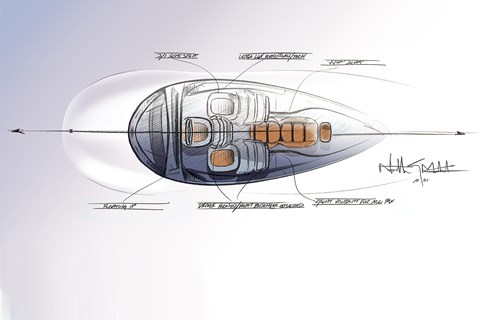► Hennessey’s building a six-wheeler!
► 2400bhp, 620-mile range planned
► Expected to go into production in 2026
Okay, so it’s still five years off, will cost $3m and six-wheeled cars don’t exactly have the greatest record of success, but still: A SIX-WHEELED CAR! It’s like it’s the 1970s all over again.
But unlike the Panther 6 and Tyrrell P34, this one might just work. Texan tuner-turned-hypercar maker Hennessey is working on a six-wheel drive, 2400bhp electric ‘hyper GT’ which it plans to put into production in 2026 at a likely price of over $3m.
What the hell is that?!
It’s codenamed Project Deep Space, and the radical new design aims to make a virtue of the six-metre length required to accommodate a long, low battery with a 1000km (620 mile) range.
Adding two more wheels increases the mechanical grip which limits the acceleration of other very high-torque electric hypercars. Deep Space’s six wheels will each have their own motor, with the complete powertrain sourced from UK electrification specialist Delta, now owned by Cosworth. Hennessey claims that the new car could be both the fastest-accelerating and most expensive EV when it goes on sale.
‘I just thought that if four electric motors are good, maybe six are better,’ John Hennessey told us.
‘I guess it will get to 60mph in under two seconds, but this isn’t intended to be a pure 0-60 or standing quarter missile. I have great respect for cars like the Rimac Nevera, but it’s hard to make a driver’s car from something that weighs over two tonnes. So, we decided to go to a completely different category of car – the hyper-GT.’

Inside, the cabin features a central driving position and two flanking passenger seats like the McLaren F1 and the Gordon Murray Automotive Type 50. But the extra length allows a fourth seat behind the driver capable of folding flat. All four seats will be accessed via two long gullwing doors, with the lower third of each door opening downwards.
And unlike the Rimac Nevera, there’s room left over for luggage: the rear boot takes four sets of golf clubs, and the front four carry-on cases.
The new Hennessey will be assembled in Texas around an entirely carbon-fibre chassis. Production will be capped at 105 cars over five years, and Hennessey says he has already taken the first order, from an existing US-based client.
Is there such a thing that could compete with this?
Deep Space is set to rival the first all-electric Bugatti, which is due before 2030 and is likely to be a four-seat GT or SUV to differentiate it from the two-seat GTs of its new partner Rimac.
‘Bugatti-Rimac are likely to have something in the luxury four-seat EV category,” Hennessey told us, “but I’m pretty sure that this will be the only six-wheel drive, 2400hp car with a diamond seating pattern from an American company. That’s a pretty unique package. We’ve learned that exclusivity resonates with our customers, and we want to be more exclusive than anyone else in the space.’

A launch date of 2026 may seem a long way off, but Hennessey sys he made the first sketches of Deep Space in 2019 and has now begun the detailed design and engineering work. The project has broken cover early because he’s concerned other manufacturers might come up with the same solution.
And unlike some of the other manufacturers to offer us six-wheeled road cars in the past, Hennessey is likely still to be around in five years time. Established 30 years ago, it made its name with its 1000bhp twin-turbo tuned Vipers and now builds 600 tuned and modified versions of American cars each year, including six-wheel drive versions of trucks from each of the US Big Three. Customer deliveries of its first ground-up design, the 1817bhp Venom F5 hypercar, start early next year. All 24 have been sold, and at least one is coming to the UK.
Deep Space is the first element of Hennessey’s new ten-year product plan to be made public. Hennessey is now seeking to establish itself as a carmaker, reducing its reliance on modifying internal-combustion engined cars from major carmakers as they switch to hybrids and EVs, which may also explain why news of its first in-house EV has been revealed so early.
At least two more variants of the Venom F5 will follow, with the first being revealed early next year. It will stay in production until 2025 but Hennessey says it will remain exclusive, with fewer than 100 being made in total.
Two more all-new models will follow Deep Space by 2031. But Hennessey isn’t giving up on gas completely: the last car in the plan, due by 2031, is expected to be powered by a pure internal combustion engine.
But Hennessey says the 1817bhp Fury engine in the Venom F5 will remain the most powerful street-legal unit it will ever produce. The car has now been homologated for the US, and approval for UK and EU sales will follow by the middle of next year.
Testing is continuing on the runway at the Kennedy Space Centre, and John Hennessey revealed to CAR that the Venom’s calculated top speed is 328mph. The current production car top speed record is held by the Bugatti Chiron Super Sport at 304.8mph.
‘But we won’t try to get anywhere near 328mph,” Hennessey says. “We’re likely to get to between 280 and 300mph at Kennedy. To go faster, we’d need five miles of Texas highway. If we could get to 500km/h or around 310mph there, I’d probably tell the driver not to push any further.’